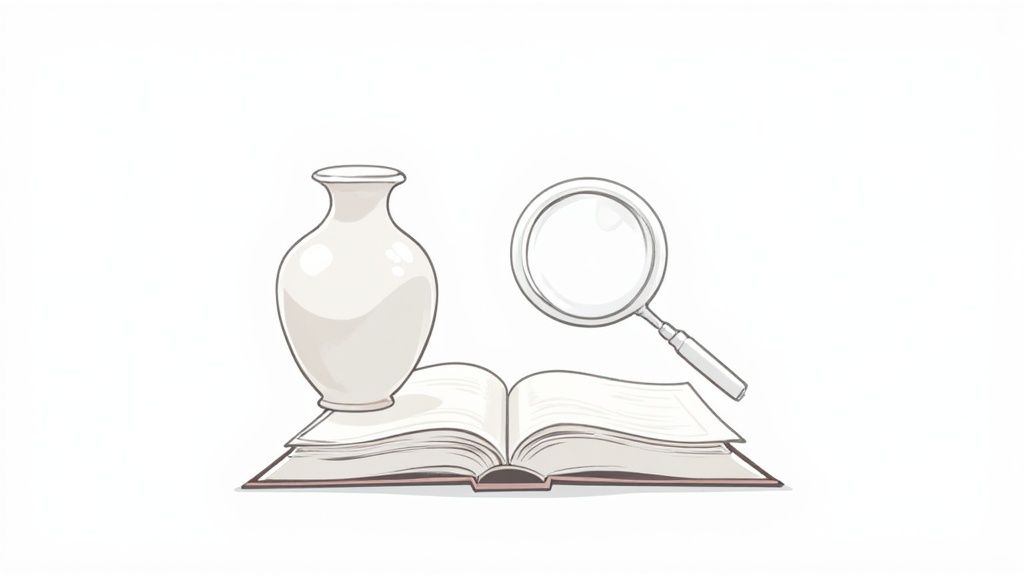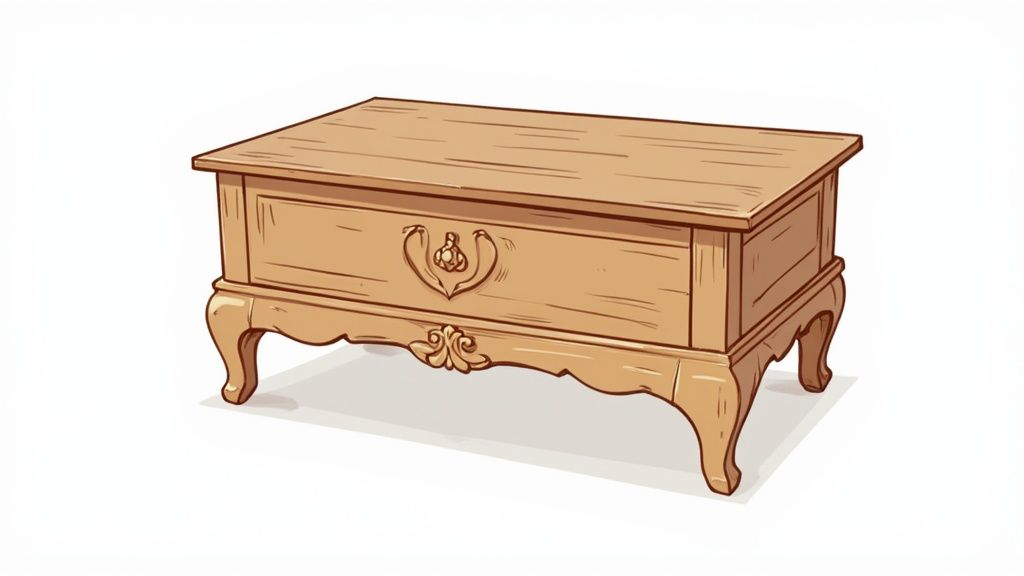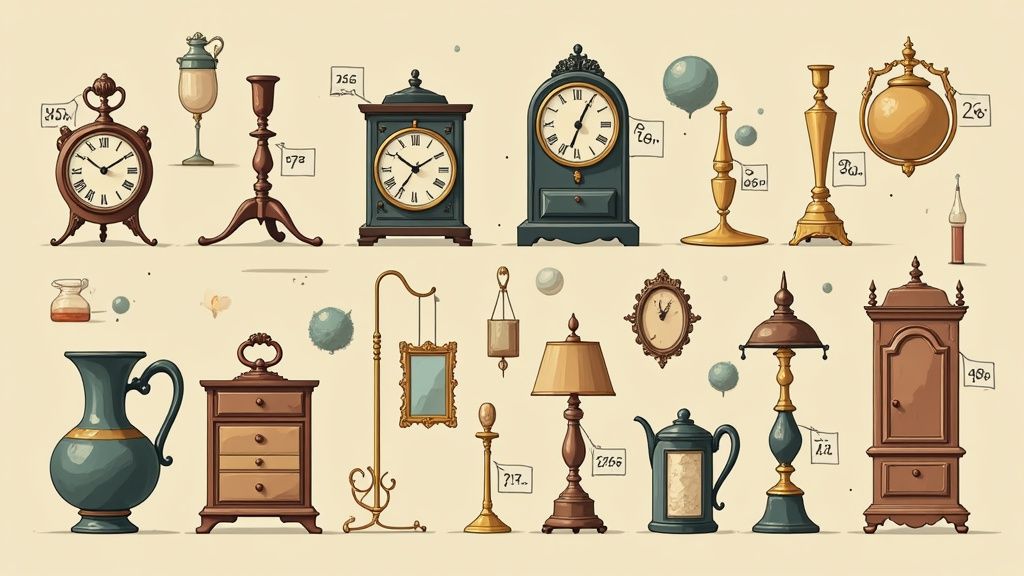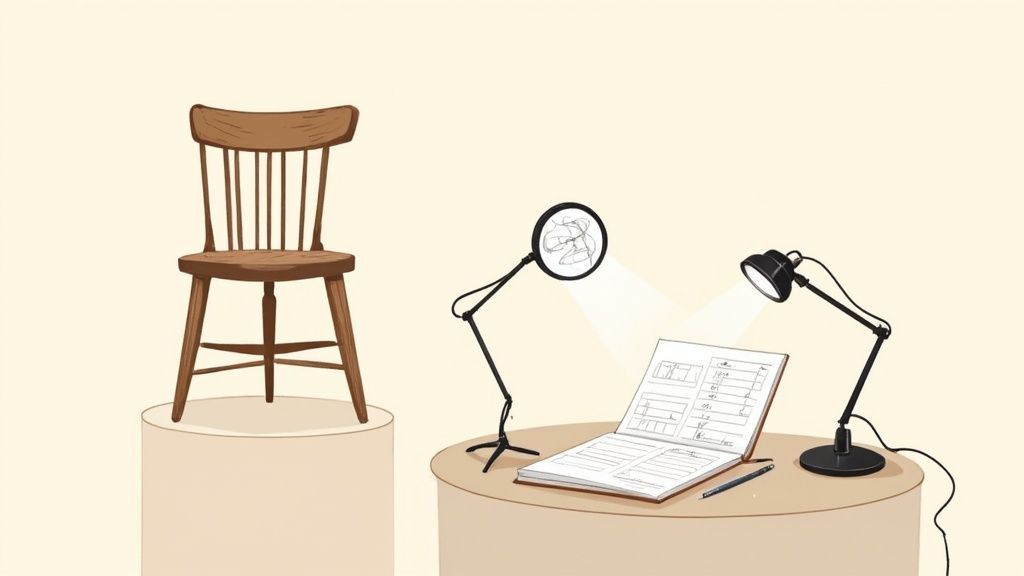Figuring out what an antique is worth isn't just about looking up a price in a book. It’s a bit of detective work, really. You have to carefully weigh four key factors: its rarity, condition, its provenance (the history of who owned it), and its overall historical significance. These elements don't exist in a vacuum; they play off each other to create the final market value.
The Four Pillars of Antique Valuation
Before you can even think about putting a number on a piece, you need a solid grasp of what makes an antique valuable in the first place. These four pillars are the bedrock of any credible appraisal. We’ll go beyond simple definitions and dig into how these factors work together to build a complete picture of an item's true worth.
Rarity and Condition
When we talk about rarity, it's not just about how few were made. It’s about how few have survived in decent shape. A factory might have churned out thousands of a particular ceramic vase back in 1910, but if only a handful are left today without chips, cracks, or serious wear, those are the ones that are truly rare.
Condition is the great equalizer. An object can be the only one of its kind, but if it's in terrible shape, the value can plummet. Even small things matter—a minor chip, a subtle repair, or aggressive cleaning that strips away the original patina can all dramatically impact the final price.
A Quick Tip from the Field: Don't automatically write off a piece because of a repair. A professional, well-executed restoration meant to stabilize a fragile item can sometimes be perfectly acceptable to collectors. On the other hand, a sloppy, modern fix on an 18th-century piece can often be worse than the original damage itself.
Provenance and Historical Significance
Provenance is the life story of an object, backed up by proof. This paper trail—old sales receipts, family letters, auction catalogs, photographs—can sometimes be even more valuable than the item itself. It confirms authenticity and provides a rich story that connects the piece directly to the past.
Here’s a classic example I’ve seen play out: imagine two nearly identical 18th-century chairs. One is simply a well-made, anonymous chair from the period. The other has a documented history proving it was owned by a famous historical figure. That second chair, purely because of its provenance, could easily be worth ten times more. This historical connection adds a layer of desirability that serious collectors find irresistible.
These pillars aren't just abstract ideas; they are the engines of a huge global market. The valuation of antiques, driven by these very factors, is a major economic force. The global antiques market brought in USD 58.4 billion in 2024 and is expected to keep growing, which tells you there's a strong and rising demand for properly authenticated pieces. You can dive deeper into the numbers with the full second-hand collectibles market report.
To help you keep these factors straight, here's a quick summary of what to look for and how it affects an antique's value.
Key Factors Influencing Antique Value
| Valuation Factor | What to Look For | Impact on Value |
|---|---|---|
| Rarity | Limited production runs, high loss rates over time, unusual variations (e.g., color, design). | High. The fewer that exist in good condition, the higher the demand and price. |
| Condition | Original finish, absence of chips/cracks, minimal wear, professional vs. amateur repairs. | Significant. Pristine items command top dollar, while damage can slash value by 90% or more. |
| Provenance | Sales receipts, letters, auction records, photos showing the item in a historical context. | Can be a massive multiplier, especially if tied to a famous person or significant event. |
| Historical Significance | Connection to a major event, a famous designer, or a pivotal moment in art/design history. | High. Adds a layer of cultural and historical importance that collectors pay a premium for. |
Considering these elements together is the key. A rare item in poor condition might be worth less than a more common piece in pristine shape. It's this careful balance that separates a casual guess from a truly informed appraisal.
Getting Your Hands Dirty: The Physical Inspection

While digging through online archives gives you a great starting point, the real story of an antique is etched into its physical form. This is where you put the books and screens aside and get up close and personal with the piece. A thorough, hands-on inspection is where the most revealing clues are often found—things that databases and photos simply can't tell you.
Your first mission is to hunt for any identifying marks. Gently turn the item over, look inside drawers, and check along the edges. You’re searching for:
- Maker’s marks: These are the little logos, symbols, or initials stamped by the manufacturer.
- Signatures: On art, pottery, or high-end craft, you might find the artist's name painted, etched, or incised.
- Labels or stamps: Old paper labels, ink stamps, or impressed marks can tell you the maker, country of origin, and sometimes even a specific production date.
Think of these marks as the antique’s birth certificate. They are your single most important key for unlocking its history and are absolutely critical for valuation. If you find a mark but can't make heads or tails of it, our guide can help you identify your antique with a bit more clarity.
Decoding What It's Made Of
After the hunt for marks, your focus should shift to the materials themselves. Is that chest of drawers solid mahogany, or is it a cleverly applied veneer? Is that ornate teapot sterling silver or just silver-plated? Getting these answers right is fundamental to the item's value.
For furniture, a giveaway for solid wood is a continuous grain pattern that wraps around the edges of a board. A veneer, on the other hand, will look like a thin, perfect layer of expensive wood glued onto a cheaper core. With silver, you're looking for hallmarks that indicate its quality. A "925" stamp or a lion symbol (the British lion passant) means sterling, whereas marks like "EPNS" (Electro-Plated Nickel Silver) tell you it's a plated piece.
An Old-Timer's Tip: Don't get star-struck by materials alone. Age, form, craftsmanship, and who made it are just as important. I've seen a humble piece of early, historically significant earthenware sell for far more than a gaudy, mass-produced porcelain piece from the 20th century.
Spotting Repairs and Alterations
This might be the most crucial part of your inspection. You need to become a detective, looking for any repairs, restorations, or later additions. These can dramatically impact an antique's value. Serious collectors crave originality, and a shoddy modern repair can sometimes be worse than the original damage.
Here are a few tricks of the trade for spotting work that isn't original:
- Bring Out the Blacklight: In a dark room, shine a UV or blacklight over ceramics, paintings, and even furniture. Modern glues, fillers, and paints often contain phosphors that will glow brightly, while the original, older materials will remain dark. It's a dead giveaway for a repaired crack in a vase.
- Trust Your Fingertips: Run your hands over the surfaces. Can you feel a difference in texture or even temperature? A repaired chip on a piece of porcelain might feel smoother or rougher than the surrounding glaze. A replaced leg on a table won't have the same dings, scratches, and patina as the originals.
- Get a Jeweler's Loupe: This little magnifying tool isn't just for jewelry. It's essential for getting a closer look at tiny details. Use it to see the difference between a hand-painted floral design and a transfer-printed one, or to spot modern screws in a piece that should have handmade ones.
By doing this careful, hands-on work, you build a complete profile of the item's physical condition. This detailed assessment becomes the solid foundation for all your other research, from tracing its history to comparing it with what's selling on the market today.
Uncovering an Antique's Hidden History

Once you’ve given an antique a good physical once-over, it’s time to put on your detective hat. The real story of an object lies in its provenance—the documented trail of who has owned it over the years. This history is what can elevate a simple old item into a treasure with significant historical, and monetary, value.
A solid paper trail is often the only thing separating an interesting curio from a priceless artifact. Your search for this history should start with the piece itself. Old papers have a way of hiding in the most obvious places, so look carefully. Check inside desk drawers, see if anything is taped to the back of a frame, or flip through the pages of any accompanying books.
You're looking for primary source documents. Keep an eye out for things like:
- Old sales receipts or bills of sale
- Handwritten letters that mention the object
- Family photos where the piece is visible in the background
- An original owner’s manual or certificate of authenticity
Expanding Your Research
After you’ve searched the item from top to bottom, your next move is to broaden the investigation. Thankfully, digital archives have made this part of the job easier than ever before. You can often access digitized records from museum collections, university archives, and historical societies right from your computer.
Auction house archives are another fantastic resource. Major houses like Sotheby's or Christie's keep extensive records of past sales. Poring through their old catalogs can reveal if a similar item has come to market, sometimes with detailed notes on its former owners.
If you’re dealing with a family heirloom, don't overlook genealogical tools. Websites like Ancestry, along with public records and census data, can help you construct a family timeline. This context can place the antique in a specific time and household, adding a wonderfully rich and personal layer to its story.
Provenance isn't just about telling a good story; it's about providing solid proof. A verifiable history gives buyers and collectors the confidence they need to invest, justifying a higher price and cementing an item's status as a genuine piece of the past.
The Power of Provenance: A Case Study
Imagine you have two diaries from the Civil War era. One was picked up at a flea market, its author unknown. It's a fascinating historical object, for sure, but it lacks context.
The second diary, however, has been traced through family letters and public records to a specific soldier who fought at the Battle of Gettysburg. Instantly, that diary transforms from an anonymous book into a firsthand account of a pivotal moment in history. Its provenance is confirmed, and its value skyrockets.
This kind of verification is critical in a market where authenticity is paramount. The global second-hand collectibles market was valued at around $142.5 billion in 2024, and forgeries are a constant concern. A well-documented history is your best shield against skepticism and your most powerful tool for unlocking an antique’s true worth. You can explore more about how provenance shapes the high-value collectibles market to understand its full impact.
Finding Reliable Market Price Comparisons

So, you've examined your antique from top to bottom and have a good handle on its story. That’s the groundwork. Now comes the crucial step: connecting your piece to the real world of dollars and cents. To get an accurate valuation, you need to see what similar items are actually fetching in the current market.
This is where many newcomers trip up. They see an item like theirs listed online and think, "Aha! That's what it's worth." But there's a world of difference between an asking price and a sold price.
An asking price is simply what a seller hopes to get. A sold price is cold, hard proof of what a buyer was actually willing to pay. This distinction is everything.
A Quick Reality Check: That gorgeous Georgian-style desk you see listed for $2,500 on a dealer's website is just a starting point. The real evidence is finding records of a similar desk that actually sold, which might have been for $1,800 after sitting on the market for months. Always anchor your appraisal in completed sales, not hopeful listings.
Digging for Sold Prices
So, where do you find this "sold" data? The best sources are online auction databases and marketplaces that make their sales history public. These platforms give you a transparent window into what the market is truly willing to bear.
Here are the go-to resources I use all the time:
- Major Auction House Archives: Websites for giants like Sotheby's, Christie's, and Heritage Auctions offer searchable databases of past sales. These are fantastic for high-end items, as the listings often include detailed provenance and realized prices.
- Auction Aggregators: Platforms like LiveAuctioneers and Invaluable are treasure troves. They gather results from thousands of smaller auction houses across the globe. You can usually filter by "sold" items to get a really broad view of the market for a specific category.
- Online Marketplaces: Don't sleep on eBay. Its power lies in the "Sold Items" filter under the advanced search options. This gives you a real-time pulse on the recent sales history for a massive variety of common and collectible antiques.
As you look for comparisons, be brutally honest about your item's condition. A mint-condition piece will always command a premium over one with visible repairs, chips, or wear. Find comps that genuinely mirror your item's state for a true apples-to-apples comparison.
Remember That Location Matters
An antique's value isn't a fixed number; it can fluctuate wildly depending on where it’s being sold. A piece of early American folk art might spark a bidding war in New England but get a lukewarm reception in Paris. The reverse is also true—European antiques often fetch their highest prices on their home turf.
These regional dynamics are a huge factor in the global collectibles market, which was valued at a staggering USD 294.23 billion in 2023. Europe, for instance, held the largest market share at 36.89%, fueled by strong local demand for items tied to the continent's deep cultural history.
This is exactly why a rare Fabergé egg could sell for $9.6 million in London. Its value is magnified by its deep connection to European history and the high concentration of passionate collectors in that specific region. Taking a moment to understand these broader collectibles market trends helps you see how geography shapes value.
For an even more direct approach to market analysis, you can also see how modern tools can help. If you're curious, our guide on how to find the value of antiques dives into a range of methods. By combining solid, old-fashioned research with a smart understanding of market psychology, you build a valuation based on evidence, not just wishful thinking.
Knowing When to Hire a Professional Appraiser
Doing your own research is one of the most rewarding parts of collecting. But there are times when an educated guess just won't cut it. Sometimes, you absolutely need the certified authority that only a professional appraiser can provide.
Knowing when to call in an expert is a crucial skill. A formal, written appraisal becomes non-negotiable in a few high-stakes situations. If you need to insure a valuable piece, settle an estate, or make a charitable donation for a tax write-off, you’ll need a legally defensible document. A self-made valuation simply won't hold up; you need an official report from a qualified pro.
Finding a Qualified Expert
So, where do you find an appraiser you can truly trust? Your best bet is to start with established professional organizations. Groups like the Appraisers Association of America (AAA) or the International Society of Appraisers (ISA) are the gold standard. They maintain directories of members who are held to rigorous ethical codes and ongoing educational requirements.
When you're vetting potential appraisers, dig into their credentials. A true professional will have:
- Formal training in appraisal theory, methodology, and ethics.
- Specialized expertise in the specific category of your item, whether it's 18th-century French furniture or vintage watches.
- Adherence to USPAP (Uniform Standards of Professional Appraisal Practice), which are the governing ethical and performance standards for the industry.
A quick but critical tip: An ethical appraiser will always charge a flat hourly rate or a fixed project fee. If someone offers to charge a percentage of the antique's value, walk away. That's a massive conflict of interest.
Understanding the Different Types of Appraisals
Not all appraisals are created equal. The type of report you commission depends entirely on its intended use, and the final value can vary dramatically as a result.
The two most common valuations you'll encounter are:
| Appraisal Type | Description | Primary Use |
|---|---|---|
| Fair Market Value (FMV) | The price a willing buyer would pay a willing seller on the open market. | Estate settlements, charitable donations, equitable distribution. |
| Replacement Value | The cost to replace an item with a similar one from a retail source. | Insurance coverage. This value is almost always higher than FMV. |
Investing in a professional appraisal gives you more than just a number on a page. It provides peace of mind and the official documentation you need for legal and financial purposes. The final report should be a comprehensive document that meticulously describes your item, explains the research process, and cites comparable sales to back up its conclusion.
Before you make the call, it helps to understand the factors that influence antique appraisal costs so you know what to expect.
Common Questions About Valuing Antiques

As you get more involved with antiques, you'll notice the same questions come up time and again. Finding clear answers is the key to moving forward with confidence, whether you're handling an inheritance or simply trying to make sense of a new find. Let's break down some of the most frequent queries I hear from fellow collectors and newcomers alike.
Antique vs. Vintage: What Is the Difference?
This is easily the most common question I get, and the answer is crucial for valuation. The rule of thumb is quite clear: for something to be a true antique, it needs to be at least 100 years old.
Anything younger, but still old enough to represent a distinct era, is generally considered vintage. This category usually covers items between 20 and 99 years old.
Think of it this way: a hand-painted porcelain teacup from 1915 is an antique. That iconic Eames lounge chair from the 1950s? It’s a fantastic piece of vintage design. Both can be quite valuable, but genuine antiques often carry a premium because of their age, historical significance, and scarcity.
Does Restoring an Antique Always Increase Its Value?
This is a big one, and getting it wrong can be a costly mistake. The short answer is a resounding no. In many cases, a poor or unnecessary restoration can completely tank an antique's value.
Serious collectors almost always prefer items in their original, untouched state. They prize the natural signs of age and use—the "patina"—that tell the object's story. A careful, professional restoration aimed only at stabilizing a piece might be acceptable. But aggressively stripping an old finish or repainting a piece of furniture? You might as well be erasing its history and its value right along with it.
Expert Advice: Before you even think about "fixing" or "cleaning up" an old item, just stop. That impulsive decision to polish away a century of character or repair what you see as a flaw could be a multi-thousand-dollar mistake. Always get an expert opinion before touching a thing.
What Should I Expect to Pay for a Professional Appraisal?
When it’s time for a formal valuation, you need to know what you're getting into financially. The cost of a professional appraisal really depends on the appraiser's experience, your location, and the complexity of the piece being examined.
- Hourly Rates: Most qualified appraisers charge by the hour. You can expect to see rates anywhere from $150 to over $400 an hour.
- Time Commitment: Even for a single, straightforward item, budget for at least one to two hours of the appraiser's time. This isn't just for the hands-on inspection; it also covers their research and the time it takes to draft a formal report.
- Ethical Red Flag: Be wary of any appraiser who wants to charge a percentage of the item's final value. This is a massive conflict of interest. A professional's fee should always be a flat hourly rate or a pre-agreed project fee. Get it in writing before they start to ensure you receive an unbiased, objective valuation.
Feeling inspired to uncover the stories behind your own items? With Curio, you can instantly identify and value antiques with just a photo. Stop guessing and start discovering. Download the app and let your treasures tell their story today.
